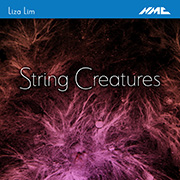 Liza Lim: String Creatures [NMC]. I’m just back from vacation and feel like apologizing for not writing about this album as soon as it came out last month. Even for listeners familiar with Liza Lim’s work, String Creatures is a revelatory and at times astonishing insight into her transformative music. The four pieces presented centre on perfomances by the JACK Quartet in Melbourne last year and were composed between 2014 and 2022. The title work that leads the set is a large quartet that would seem to dominate the album, at first: it grabs your attention from the first moment with its opening violin aria played in a sour and resonant baritone, an uncanny effect achieved by tuning the bottom string an octave lower. Lim has fashioned a unique and remarkably coherent language for string instruments, achieved through a synthesis of eclectic influences and empirical experimentation. Extended techniques are likely as not to be drawn from other cultures such as folk fiddling (Hardanger and Bluegrass) as from the postwar avant-garde. The most extraordinary thing about String Creatures is that, even with its dazzling array of new sounds and extremes of colouration, it always feels like the effects are a natural means to an end, producing a complex expressive statement on the relationship between physical activity and emotional need: a Romantic disquisition made through a renewed, corporeal language.
Liza Lim: String Creatures [NMC]. I’m just back from vacation and feel like apologizing for not writing about this album as soon as it came out last month. Even for listeners familiar with Liza Lim’s work, String Creatures is a revelatory and at times astonishing insight into her transformative music. The four pieces presented centre on perfomances by the JACK Quartet in Melbourne last year and were composed between 2014 and 2022. The title work that leads the set is a large quartet that would seem to dominate the album, at first: it grabs your attention from the first moment with its opening violin aria played in a sour and resonant baritone, an uncanny effect achieved by tuning the bottom string an octave lower. Lim has fashioned a unique and remarkably coherent language for string instruments, achieved through a synthesis of eclectic influences and empirical experimentation. Extended techniques are likely as not to be drawn from other cultures such as folk fiddling (Hardanger and Bluegrass) as from the postwar avant-garde. The most extraordinary thing about String Creatures is that, even with its dazzling array of new sounds and extremes of colouration, it always feels like the effects are a natural means to an end, producing a complex expressive statement on the relationship between physical activity and emotional need: a Romantic disquisition made through a renewed, corporeal language.
On that corporeality: I remember many, many years ago attending a public workshop of Lim’s early string quartet Hell. After the first run-through, she told the musicians they were playing the notes too well. Where her score called for notes to be played hard, or faint, or off-pitch, she really wanted the physical impact to be heard and felt, removing the quartet from being a sophisticated ensemble and towards becoming an organic complex, all sound as a product of friction and breath. With the JACK Quartet, Lim pushed this line of thinking much further: “Lim asked the players to learn rope tricks and to literally tie each other’s hands to their instruments, exploring the sounds that resulted as the musicians struggled free.” Having learned the music inside-out, as it were, it follows that JACK’s playing of these challenging pieces is entirely fluid and eloquent, speaking in strange intonation, nasal falsetto and harsh gutturals with a discursive flow as though it were their mother tongue.
So there are strings and there are strings: JACK cellist Jay Campbell plays solo on an ocean beyond earth, on two instruments; or rather between two instruments. Each string on his cello is attached by a rosined thread to a string on a retuned violin; pulling on a thread sets off faint resonances between the two instruments. It’s a still, otherworldly work that finds portent in its quietness, fitting the subject matter that inspired it, of interpreting a signal received from space. The perception is clear even as the outline is diffuse. The brief The Weaver’s Knot is a string quartet which compresses the activity of its argument into a single movement a little over five minutes long – it’s short but not small. For the final work, The Table of Knowledge, JACK is joined by Rohan Dasika on double bass. The deeper pedal tones play off against odd harmonics, creating a queasy, distorted form of exotica. The knowledge Lim alludes to can be discerned from the titles of each movement: Datura, Belladonna, Henbane, Cannabis. It’s a heady mix of the alluring and the repellent which has underlaid her music all the way back to her early chamber piece Garden of earthly desire, an embrace of the uneasy relationship between the physical and the spiritual that makes her otherwise esoteric idiom so compelling. The long final movement, “Flying”, transcends what has gone before it with a strange solo by Dasika, playing bass while holding a taut thread in his mouth, attached to the bass’s top string. His mouth acts as a resonator, producing a kind of overtone singing multiplied by the sympathetic vibrations of the instrument. As a final transformation, he music floats somewhere between bowed string and voice, never fully one nor the other, at once more than and less than human.
